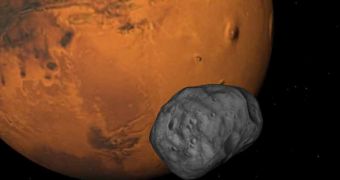If an asteroid hits the Red Planet, it could be the second time in history when humanity witnesses a collision between a celestial body and a planet in the solar system, other than the Earth, since the event in 2004 when the broken comet Shoemaker-Levy 9 intersected the orbit of Jupiter, creating giant fireballs in its atmosphere, most of them bigger than the diameter of our planet.
Astronomers have been closely following the chunk of rock for the last few months, and previously estimated the chances of a hit at about 1 in 350. However, this week, the odds suddenly increased to 1 in 75 after a recalculation of the asteroid's orbit. According to NASA's Near Earth Object Program, which tracks most of the large asteroids in the proximity of the Earth, and some in the solar system, the asteroid dubbed 2007 WD5 should execute a fly-by in January 30 next year.
Currently orbiting somewhere between the Earth and Mars, at approximately half the distance between the two planets, the 2007 WD5 asteroid is about the size of the asteroid that hit the Earth in 1908, and exploded about 5 kilometers above the surface, in the region of Siberia near the village of Tunguska. It was estimated to have had a diameter slightly larger than 100 meters and detonated with a force equivalent to 10 to 20 megatonnes of TNT, leveling more than 200 square kilometers of forest.
Following the trend observed in the last months, Steve Chesley from NASA's Jet Propulsion Laboratory argues that they are expecting a further drop in the chances of a direct hit, as a result of the observations during the following week. However, he stated that, although the chances are still growing, the most likely result will be a fly-by, thus it will miss Mars.
Nevertheless, if the asteroid does hit the Red Planet, then it will most probably fall in the equatorial area of the planet, in the general region where NASA's Martian rover Opportunity is located, and has been studying the surface for more than four years. The rover will probably not be affected by the impact, since it lies well beyond the impact area.
Depending on its density, the impactor could create a crater having the size of the one on Earth, located in the United States, the famous Meteor Crater in Arizona. Traveling at about 12.8 kilometers per second, this could be the first recorded asteroid impact with another planet in history.

 14 DAY TRIAL //
14 DAY TRIAL //